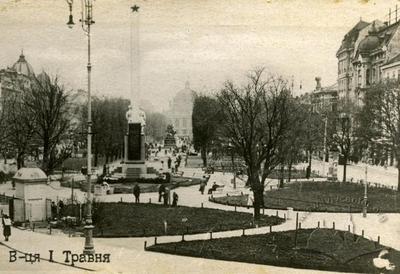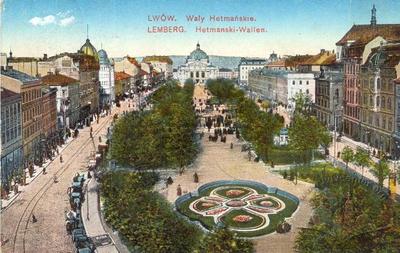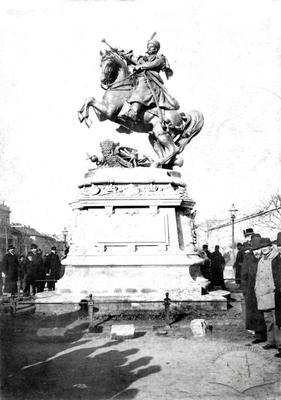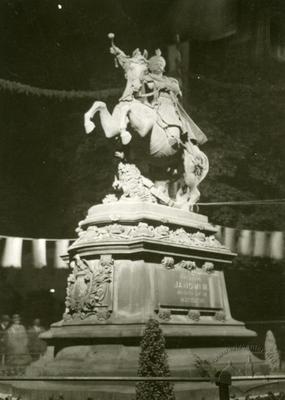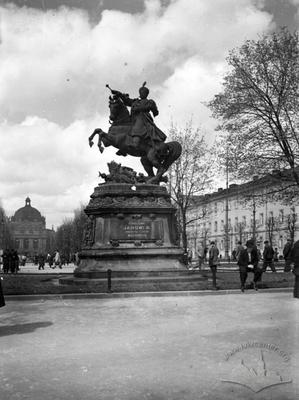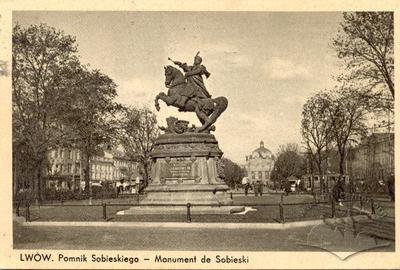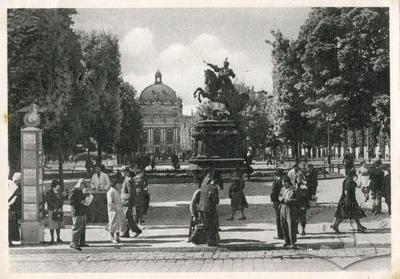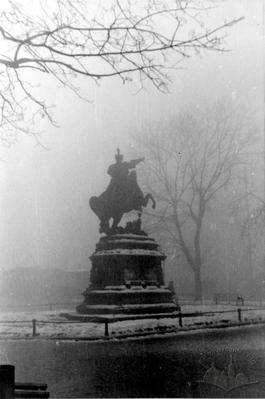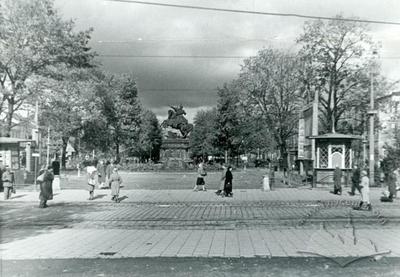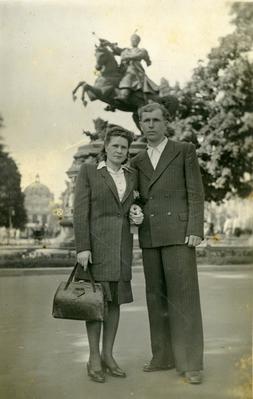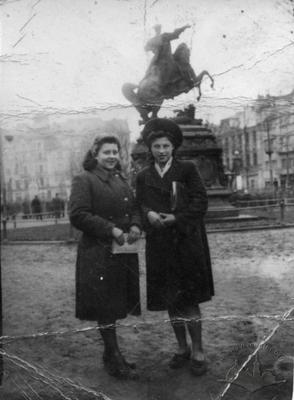
Prosp. Svobody – former monument to Jan III Sobieski ID: 96
The grand opening of the monument to the King of Poland took place on November 20, 1898. The monument was made by the famous Lviv sculptor Tadeusz Baroncz. After World War II, in 1950, the monument was moved to Poland where for almost twenty years it was located in Wilanowski Park in Warsaw while discussion continued about its appropriate location. In 1987 the monument to Jan III Sobieski was ceremonially unveiled on Wooden Market in Gdansk.
Story
There had been three monuments to the king in Lviv. A marble bust, made in 1883, was placed in the National Museum. The second one, also a bust, appeared in the courtyard of the Polish Towarzystwo Kurkowe (riflemen's society) on what is now vul. Lysenka, 23a, in 1891 (Biriulow, 2007, 96). An equestrian statue on Wały Hetmańskie (now prosp. Svobody) was opened on 20 November 1898. The author of all three monuments was Tadeusz Barącz, a famous Lviv sculptor.
The monument consisted of a bronze figure cast by the company of Artur Krupp in Vienna and a tall Neobaroque pedestal made of sandstone in the workshop of Julian Markowski, a Lviv sculptor. According to Yuriy Biriulow's research, the first model of the monument was completed by Barącz in 1888; however, the sculptor remade it time and again during the following ten years (Biriulow, 2007, 96).
The monument to Jan III Sobieski was established in Lviv by no mere chance. Sobieski was the only Polish king who came from the outskirts of Lviv: he was born in Olesko, owned estates in Zolochiv, Pomoriany, Zboriv, Pidhirtsi, Zhovkva, Yavoriv, as well as at Wilanów (near Warsaw). He often stayed in Lviv (in particular, in the Royal Townhouse). Presumably, the monument to the Polish national hero was set up because he was also honored by Austrians, as in 1683 the king successfully led the defense of Vienna from the Turkish and Tatar siege, which involved the troops of the Holy Roman Empire, the Polish-Lithuanian Commonwealth, the Zaporizhian Cossacks, as well as Saxon and Bavarian armies.
Polish demonstrations were often held on the area around the monument.
In the early years of the Soviet rule in Lviv, this monument was compared with the monument to Bohdan Khmelnytskyi in Kyiv because of their external similarities. In 1950 the monument was transported to Poland, where it stood in the park of the Wilanów Palace in Warsaw, one of the monarch's residences, for about fifteen years. Subsequently, it was transferred to Gdansk, as Sobieski was also linked with this city in a number of ways. In 1965, the monument was installed on the Targ Drzewny (Wooden Market) square, where, before 1946, there was a German obelisk monument to the Prussian soldiers who fell in the wars with Denmark, Austria, and France.
In the place of the removed monument in Lviv, there was a flower bed, and in 1992 a monument to Taras Shevchenko was installed nearby.
Architecture
The monument was located in the middle of a pedestrian boulevard, between Karla Ludwika and Hetmańska streets (now prosp. Svobody).
The equestrian bronze statue was installed on a tall Neobaroque pedestal made of grey Ternopil sandstone with the following inscription in golden letters: "Królowi Janowi III, miasto Lwów, MDCCCXCVIII" (To the King Jan III, the city of Lviv, 1898). This inscription was removed during the relocations of the monument; however, it was restituted in 1989. The inscription on the other side indicated the places — Podhajce 1667, Bracław 1671, Mohylów 1671, Kalnik 167, Krasnobród 1672, Niemirów 1672, Komarno 1672, Kałusz 1672, Chocim 1673, Bar 1674, Lwów 1675, Trembowla 1678, Wojniłów 1676, Żurawno 1676, Wiedeń 1683, Parkany 1683, Jazłowiec 1684, Zwaniec 1684, Jassy 1686, Suczawa 1691 — where the king waged battles, victorious for the Polish troops. In the front part of the pedestal, there were the emblems of Poland and Lithuania, and, in the rear, there was the family coat of arms of the Sobieskis, the Janina. Also, the pedestal was decorated with rich friezes having cartouches, crowns, scepters on them (Słowo Polskie, 1898, No. 278, s. 4).
Jan Sobieski is depicted in the monument at the moment when he jumps on horseback over an enemy cannon and smashed remnants on the battlefield. At the same time, he is dressed in festive, not military clothes, which at the time was criticized because of a false representation of historical realities (Dziennik Polski, 1895, No. 133, 2).
Related buildings and spaces
People
Sources
- Dziennik Polski 22/9/1893 №263, 3
- "Pomnik króla Jana Sobieskiego", Dziennik Polski 14/5/1895 №133, 2
- Gazeta Narodowa, 10/10/1890 №236, 2
- a href="http://anno.onb.ac.at/cgi-content/anno?aid=klw&datum=18930624&seite=5&zoom=33">"Pomnik Sobieskiego", Kurjer Lwowski, 1893, №173, 5
- "Pomnik Sobieskiego... w powietrzu", Kurjer Lwowski, №176, 5
- "Ze spraw miejskich. Pomnik Jana III", Słowo Polskie 3/12/1896 №283, 2
- "Pomnik Sobieskiego", Słowo Polskie 21/9/1898 №278, 4
- "Tadeusz Barącz", Słowo Polskie 27/11/1898 №283, 5
- Aleksander Czołowski, Król Jan III i jego pomnik we Lwowie (Lwów, 1898), 32
- Rafał Borowski, "Ze Lwowa przez Warszawę do Gdańska. Historia pomnika króla Jana III Sobieskiego"
- Ігор Мельник, Роман Масик, Пам'ятники і меморіальні таблиці міста Львова, (Львів: Апріорі, 2012), 88-90
Urban Media Archive Materials
